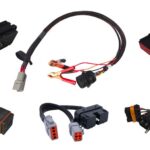The intake manifold temperature sensor in a Detroit DD15 engine plays a crucial role in optimizing engine performance and fuel efficiency. This sensor measures the temperature of the air entering the engine, allowing the Engine Control Module (ECM) to adjust fuel delivery and ignition timing for optimal combustion. A faulty Dd15 Intake Manifold Temp Sensor can lead to various issues, impacting engine performance and fuel economy. This article will discuss common symptoms of a failing sensor, how to test it, and the replacement process.
Symptoms of a Faulty DD15 Intake Manifold Temp Sensor
A malfunctioning intake manifold temperature sensor can manifest in several ways, including:
- Poor Fuel Economy: The ECM might incorrectly calculate the fuel mixture leading to increased fuel consumption.
- Rough Idling: Inconsistent air/fuel mixture can cause the engine to idle unevenly or stall.
- Hesitation or Stalling: The engine might hesitate or stall during acceleration due to incorrect fuel delivery.
- Increased Emissions: A faulty sensor can disrupt the combustion process, resulting in higher emissions.
- Check Engine Light: The ECM might detect the faulty sensor and trigger the check engine light on the dashboard, often accompanied by a specific diagnostic trouble code (DTC).
- Hard Starting: Difficulties starting the engine, especially in cold weather, can be attributed to inaccurate temperature readings.
- Black Smoke from Exhaust: Excessive black smoke indicates incomplete combustion, potentially caused by a faulty temperature sensor.
Testing the DD15 Intake Manifold Temp Sensor
Testing the intake manifold temperature sensor involves a few steps:
-
Locate the Sensor: The sensor is typically located on the intake manifold, near the throttle body. Consult your DD15 engine service manual for the precise location.
-
Disconnect the Sensor: Carefully disconnect the electrical connector from the sensor.
-
Measure Resistance: Use a digital multimeter to measure the resistance across the sensor’s terminals. The resistance should change with temperature. Consult the service manual for the correct resistance values at different temperatures. You can use a heat gun or hair dryer to carefully warm the sensor while monitoring the resistance changes. A stable or incorrect reading indicates a faulty sensor.
Replacing the DD15 Intake Manifold Temp Sensor
Replacing the sensor is a relatively straightforward process:
- Disconnect Battery: Disconnect the negative battery cable to prevent electrical shorts.
- Remove the Old Sensor: Use the appropriate wrench or socket to carefully remove the old sensor from the intake manifold.
- Install the New Sensor: Install the new sensor, ensuring it is properly seated and tightened to the manufacturer’s specifications.
- Reconnect Electrical Connector: Reconnect the electrical connector to the new sensor.
- Reconnect Battery: Reconnect the negative battery cable.
- Clear Codes: Use a diagnostic scanner to clear any stored DTCs related to the intake manifold temperature sensor.
Conclusion
The DD15 intake manifold temperature sensor is a critical component for optimal engine performance and fuel efficiency. Recognizing the symptoms of a faulty sensor and knowing how to test and replace it can save you time and money. If you suspect a problem with your DD15 intake manifold temperature sensor, it is recommended to consult a qualified diesel mechanic for proper diagnosis and repair. Regular maintenance and timely replacement of faulty sensors will help keep your DD15 engine running smoothly and efficiently.

